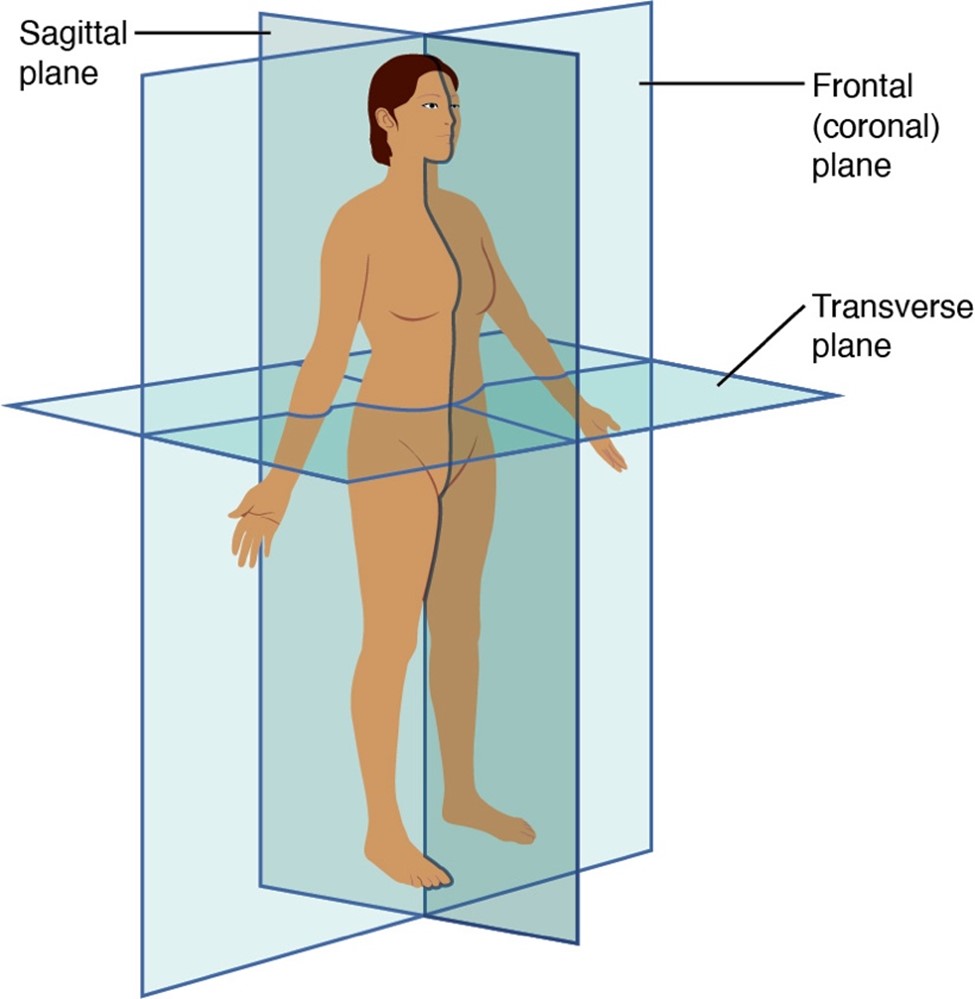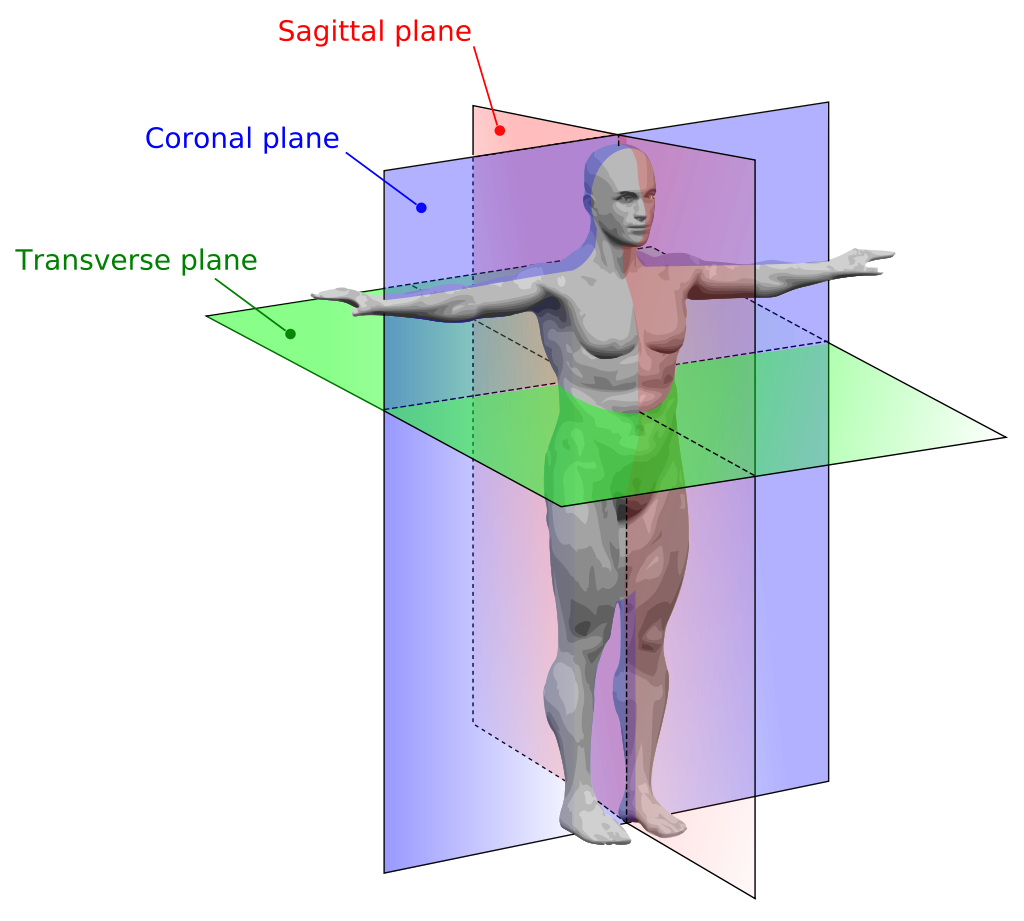Anatomic Planes Could Best Be Described as
The motion in the frontal plane occurs sideways. The frontal plane could best be described as an imaginary field running through the body and dividing it into.

Anatomical Position Planes And Locations Bone And Spine
The motions that come under this anatomical plane are commonly described as abduction and adduction.

. The sagittal plane divides the body or an organ vertically into right and left sides. Imaginary lines drawn across the abdominopelvic region c. However there are bibliographies that admit a fourth plane.
Medical professionals often refer to sections of the body in terms of anatomical planes flat surfaces. Every other anatomical position is described with respect to this standard position. Let me tell you about these standard planes in detail.
Updated on July 03 2019. Unequal left and right sides. The anatomic position could best be described as a.
Directional term descriptions definitions example labeled diagrams of sagittal coronal transverse oblique and longitudinal axis. Anterior and posterior portions. These planes are the different directions a body is cut to reveal different views of its internal structures.
It separates the superior from the inferior or the head from the feet. The medical term meaning to the right and left of the umbilical region near the waist is. Anatomical Planes in a Human.
A human in the anatomical position can be described using a coordinate system with the Z-axis going from front to back the X-axis going from left. Quiz yourself on how each plane divides the body into front anterior and back posterior portions right and l. The umbilical region refers to.
You can think of midline and middle to remember the definition of midline. Anatomical position is the description of any region or part of the body in a specific stance. They are especially important to know if you plan to enter a healthcare field that involves analyzing images from MRI machines and other types of imaging equipment.
To view the interior of a body we expose the organs and structures that are visible when that body is cut open along one of four commonly used sectional planes. These planes are often used to describe location of structures or. One can be sitting down or standing up _____ b.
The standard anatomical position is considered the reference position for a given organism. The coronal plane frontal plane slices the body into two halves namely the front side and backside. In this position a person is standing upright with the lower limbs together or slightly apart feet flat on the floor and facing forward upper limbs at the sides with the palms facing forward and thumbs pointing away from the body and.
The anatomical planes mainly used for anatomical descriptions are three. Anatomical position body planes anatomy sections. The midline median plane or midsagittal plane is an imaginary vertical line down the middle of the body and it divides the body into equal right and left sections.
If this vertical plane runs directly down the middle of the body it is called. The midline will be our reference point when describing medial and lateral. The terms are used to describe a specific body part.
Science Anatomy and Physiology QA Library Which of the following correctly describes the anatomic position. Terminology three references plane are considered standard planes. Image captured in AR using Human Anatomy Atlas.
For humans the standard position is at rest standing erect while facing forward. Right Z-axis from front to back and Y-axis from up to down. A transverse plane also known as axial or horizontal plane is parallel to the ground.
The palms of the hands are facing backwards 2. An imaginary plane b. Check all that apply _____ a.
The coronal plane the sagittal plane and the parasaggital planes are examples of longitudinal planes. A reference point when using directional terms d. There are three planes commonly referred to in anatomy and medicine as illustrated in Figure 143.
Sagittal coronal and horizontal. The standard anatomical position is agreed upon by the international medical community. The upper limbs are at the bodys sides with the palms facing forward.
In the anatomical position the body is upright directly facing the observer feet flat and directed forward. Planes differentiate the body anterior and posterior ventral and dorsal dexter and sinister portions. A plane is an imaginary two-dimensional surface that passes through the body.
In human anatomy the anatomical planes are defined in reference to the anatomical model being in the upright or standing orientation. In anatomy and physiology the anatomical body planes and sections help us understand the various ways in which the body can be viewed when cut into sections. There are three basic planes in zoological anatomy.
What are the anatomical parts of the body. Sagittal coronal and transverse. Standard Anatomical Position in Humans.
These planes are imaginary lines vertical or horizontal drawn through an upright body. No two bones of the body can cross each other _____ d. The sagittal plane runs vertically and divides the body into right and left portions.
Anatomical Reference Planes A plane is a theoretical line that divides the body. The function of anatomical planes is to serve as a spatial reference to facilitate the description and location of organs and body structures. The body is also divided by three imaginary planes known as the sagittal plane coronal plane and transverse plane.
The coronal plane or frontal plane vertical divides the body into dorsal and ventral back and front or posterior and anterior portions. It comprises a head neck trunk which includes the thorax. The coronal plane runs vertically separating the body into a front and a back half.
The side-to-side movement is the hallmark of frontal plane motion. The two feet are directed forward _____ c.


Komentar
Posting Komentar